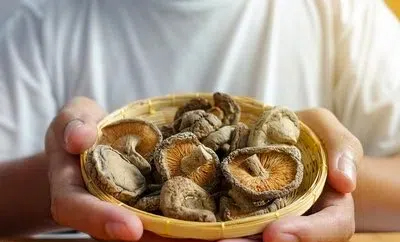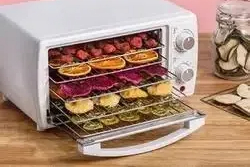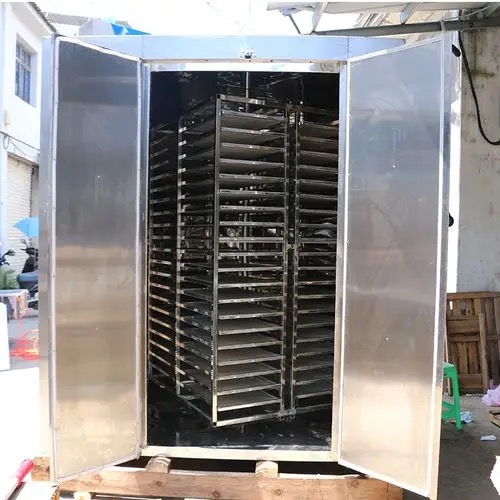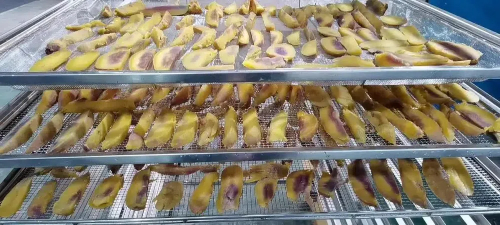
Content Menu
● Understanding Food Dryers
>> How Food Dryers Work
>> Comparison of Different Food Drying Methods
● Benefits of Using Food Dryers
● Choosing the Right Food Dryer
● How to Use a Food Dryer
>> Tips for Making Jerky and Other Snacks
● Recipes for Dried Foods
● Maintaining Your Food Dryer
Conclusion
● Frequently Asked Questions
>> 1. What types of foods can be dried?
>> 2. How long does it take to dry food?
>> 3. Can I dry food without a dehydrator?
>> 4. What is the best temperature for drying fruits?
>> 5. How do I store dried foods properly?
Understanding Food Dryers
Food dryers, also known as dehydrators, are appliances designed to remove moisture from food. They come in various types, including electric dehydrators, solar dehydrators, and even oven drying methods. Electric food dryers are the most common, utilizing fans and heating elements to circulate warm air around the food, effectively drying it out.

How Food Dryers Work
Food dryers operate by using a combination of heat and airflow. The heat causes moisture in the food to evaporate, while the airflow helps to carry the moisture away, preventing it from reabsorbing into the food. This process can take several hours, depending on the type of food and the desired level of dryness.
Comparison of Different Food Drying Methods
While food dryers are popular, other methods such as air drying, sun drying, and oven drying also exist. Each method has its pros and cons. For instance, sun drying is energy-efficient but depends on weather conditions, while oven drying can be less effective due to uneven heat distribution.
Benefits of Using Food Dryers
Using a food dryer offers numerous benefits. Dried foods retain most of their nutrients, making them a healthy snack option. Additionally, drying food at home can save money compared to purchasing pre-packaged dried foods, which often contain preservatives and added sugars. The versatility of food dryers allows users to experiment with various foods, creating unique snacks and ingredients for cooking.
Choosing the Right Food Dryer
When selecting a food dryer, consider factors such as capacity, temperature control, and ease of use. Some popular brands include Excalibur, Nesco, and Cosori, each offering a range of models to suit different needs and budgets. Prices can vary significantly, so it's essential to find a model that fits your requirements without breaking the bank.

How to Use a Food Dryer
Using a food dryer is straightforward. Start by preparing your food—wash, peel, and slice fruits and vegetables as needed. Arrange them in a single layer on the drying trays, ensuring good airflow. Set the temperature according to the type of food you are drying, and let the dryer do its work. For jerky, marinate the meat beforehand and slice it thinly for even drying.
Tips for Making Jerky and Other Snacks
When making jerky, choose lean cuts of meat and marinate them for at least a few hours to enhance flavor. For fruits, consider using a light syrup or lemon juice to prevent browning. Experiment with different spices and seasonings to create unique flavors.
Recipes for Dried Foods
Dried fruits can be enjoyed as snacks or used in baking. For example, dried apples make a great addition to oatmeal, while dried tomatoes can enhance pasta dishes. Jerky can be seasoned with various spices, from classic teriyaki to spicy chili, catering to different taste preferences.
Maintaining Your Food Dryer
To ensure your food dryer lasts for years, regular cleaning is essential. After each use, wipe down the trays and the interior with a damp cloth. Avoid using harsh chemicals that could damage the appliance. If you encounter issues, refer to the user manual for troubleshooting tips.
Conclusion
Food drying is a valuable skill that can enhance your culinary repertoire while promoting healthier eating habits. With the right food dryer, you can preserve seasonal fruits and vegetables, create delicious snacks, and save money in the process. Embrace the art of food drying and enjoy the benefits it brings to your kitchen.

Frequently Asked Questions
1. What types of foods can be dried?
Most fruits, vegetables, herbs, and meats can be dried. However, some foods, like high-fat items, do not dry well.
2. How long does it take to dry food?
Drying times vary based on the type of food and the dryer used, typically ranging from a few hours to over 12 hours.
3. Can I dry food without a dehydrator?
Yes, you can use an oven or air dry food, but these methods may not be as efficient as using a dedicated dehydrator.
4. What is the best temperature for drying fruits?
Fruits are generally dried at temperatures between 125°F to 135°F (52°C to 57°C).
5. How do I store dried foods properly?
Store dried foods in airtight containers in a cool, dark place to maintain freshness and prevent moisture absorption.












